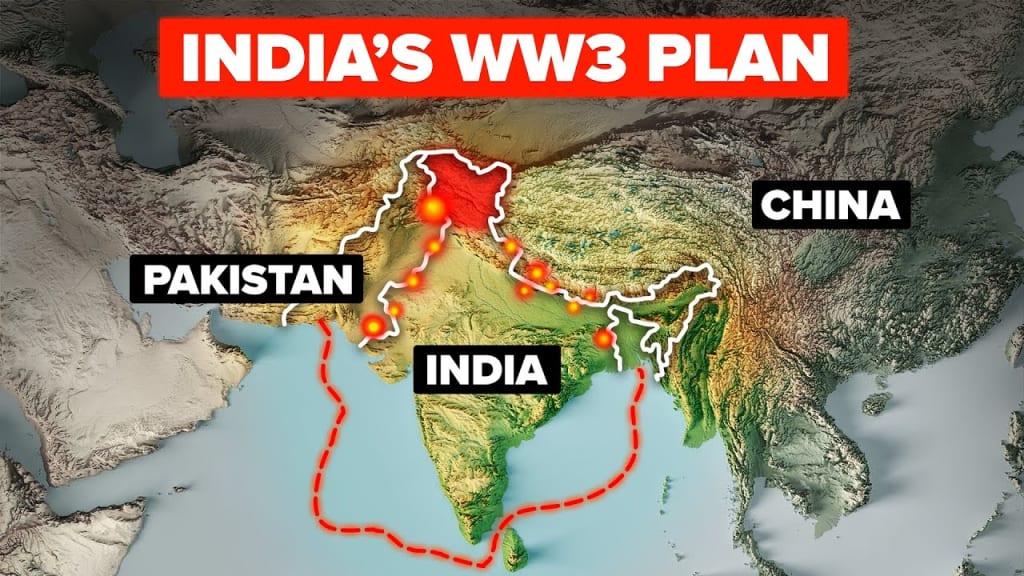India's Third World War Strategy
India has the unfortunate circumstance of having two opposing neighbors on its borders. It also has the advantage of having a better strategic position. See how India is preparing for World War III in today's stunning new narrative! 🕵️♂️🤯🤯🕵️♂️

India has the unfortunate circumstance of having two opposing neighbors on its borders. It also has the advantage of having a better strategic position. See how India is preparing for World War III in today's stunning new narrative! 🕵️♂️🤯🤯🕵️♂️
India has the unfortunate circumstance of having two adversarial neighbors directly along its borders. It also enjoys the good fortune of being in a better strategic position. This is how India will combat in World War 3. India is effectively a fortress nation because of its geography, much like the United States. However, India's fortress has one weak spot in its defenses, unlike the United States, which is shielded by two enormous oceans and a polar ice cap. India's northern neighbor is China, with which it initially enjoyed good relations. The non-aligned movement, which sought to prevent their countries from being coerced into either the American or Soviet camp during the Cold War, was sparked by both India and China.
However, tensions over an unresolved northern border dispute and China's inclination toward the Soviet Union soon caused the relationship to deteriorate. Relations reached an all-time low in 1950 after China invaded and occupied Tibet, three significant conflicts—including a full-fledged war that China technically won in 1962—have since broken out between China and India. Indian and Chinese troops engaged in two standoffs that threatened to restart the two countries' war in 1967 and 1987. However, the relationship significantly improved in the new millennium—until the 2010s, when a number of border disputes once again threatened the shaky peace. The most serious conflict, which claimed the lives of 20 Indian soldiers and an undetermined number of Chinese, occurred in 2020.
These conflicts have become more intense. According to a US congressional investigation, China had prepared for the conflict in advance, taking possible casualties into account. This was not by chance, as evidenced by China's continued success in its objectives and the further Indian control in the region was pushed back. India's long-standing foe, Pakistan, is to its west. Over the past 70 years, the two countries have engaged in numerous conflicts, with India typically triumphing over its smaller neighbor. Though many terror attacks in India have been directly linked to Pakistan's intelligence services, Pakistan soon began directly funding and arming terrorists to attack India asymmetrically. Today's tenuous peace between the two nuclear-armed countries still exists, but India's non-alignment policy has ended as a result of Pakistan's realignment with China.
India has taken some very historic steps in forging closer ties with the United States after realizing that it needs allies in this brand-new, significantly more dangerous world. Russia has historically been India's closest ally among the two superpowers, but significant failures on Russia's part in developing joint weapon systems, like the SU-57, as well as its significantly diminished status on the international stage and Russia's own growing ties to China are working to sever that relationship. India is now considering possibly acquiring more American weapons and realigning its policies to align with those of the US and its allies in the west. The Himalayan Mountains, which form a border that is almost impenetrable against any potential Chinese incursion, completely enclose India's northern border.
China invaded Tibet in order to stop it from being used as a staging area for a potential Indian invasion against it and to secure the headwaters of numerous rivers that are crucial for the Chinese nation. China invaded Tibet after quickly realizing that it sat on the low end of the strategic high ground. Since then, China has worked to reassert its control over areas once under Indian control on its side of the Himalayas. This is done in an effort to deny India the chance to seize plateaus and build logistical bases from which to fly in large pieces of equipment. India cannot use heavy equipment in a conflict with China because China has built its own and India has not. However, India's strong air defense system also ensures that, even if China has taken the high ground, a southern invasion of the country is suicide.
China's forward position in the Himalayas does mean that it will undoubtedly lose what little control it has over the Himalayan region, but India has little to fear from a ground war with China. The western border with Pakistan is India's main source of worry. Over the years, Pakistan has typically lost a lot of battles with India, and now India is a militarily much stronger force than Pakistan. With such a disproportionate amount of military force, India would unquestionably prevail in a modern conflict between the two countries and could even pose a threat to the Pakistani national government. Pakistan has openly stated that it would be willing to use nuclear weapons to defend itself in a future war for this reason, placing India in an extremely challenging position.
India has developed a "deep strike" doctrine, wherein Indian forces concentrate power in a condensed area of the front to achieve a deep, penetrating offensive into Pakistan itself, in an effort to neutralize this threat or at the very least reduce its effectiveness. As a result, Pakistan would be forced to use nuclear weapons on its own soil if it wanted to use them at all, placing Indian forces inside Pakistani territory. A conventional war between India, China, and unavoidably Pakistan—with Chinese forces stationed in Pakistan itself—would pose a greater threat to India. China is free to use its ground forces outside of its own borders without concern for invasion, and given that the Chinese military is generally superior to India's, India would be at serious risk if the two powers combined for a major offensive.
This is improbable but not impossible and would unavoidably enlist the US and other superpowers on India's side. The lack of a domestic arms industry and the disparate nature of India's current military equipment are the country's two biggest problems. As an unaligned state, India has been very opportunistic and has chosen to arm itself with what it considered the weapons that best suited its needs from both the west and the former Soviet Union, now Russia. This has put it in the unusual position of not having particularly strong defensive ties to either of them, which is the main reason why India is not a partner with any country that fields advanced fifth-generation fighters at this time.






Comments
There are no comments for this story
Be the first to respond and start the conversation.